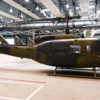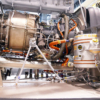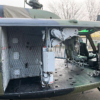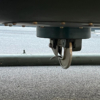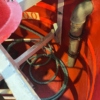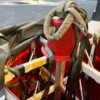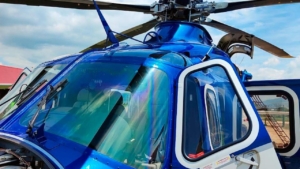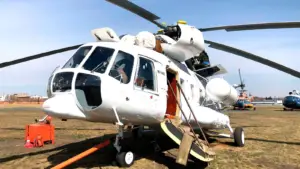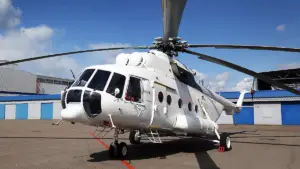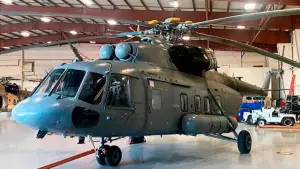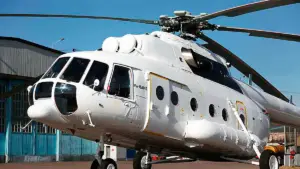Description
The UH-1D Huey is a German version of the American multi-role helicopter UH-1 Iroquois, produced under license in Germany. The Huey is a light transport helicopter (LTH). It is used as a search and rescue helicopter.
The Iroquois was originally designated HU-1, hence the nickname “Huey”, which is still widely used despite its official redesignation as UH-1 in 1962.
The success of the Iroquois helicopters did not go unnoticed by the US allies: the West German government also became interested in these machines, purchasing a license to produce helicopters at German factories. From February 1967 to the end of 1981, German aircraft manufacturers produced 352 helicopters, designated UH-1D, but they were built to the standard of the American version of the UH-1H with a Lycoming-T53-L13 engine. These helicopters remained in German service until June 2021.
Features of the UH-1D Huey
The UH-1D is a stretched version of the original UH-1B, designed to carry more troops and cargo. It is powered by a turbine engine and has a distinctive, recognizable shape with two-blade main and tail rotors.
Application
The Huey series helicopters have been used in a variety of applications, including troop transport, medical evacuation (MEDEVAC), search and rescue (SAR), and as combat aircraft. The UH-1D variant was widely used for troop transport, and could carry up to 12 fully equipped soldiers.
Configuration
The UH-1D is equipped with two large sliding doors on each side, facilitating quick and convenient entry and exit for troops and cargo.
Application today
Although new helicopter models have replaced the UH-1D in many military and rescue missions. Some countries continue to use modified and upgraded versions of the UH-1D helicopter for various missions, such as cargo transportation.
Huey today is designed to perform a variety of tasks:
- Firefighting;
- Law enforcement agencies;
- Rescue missions.
The UH-1 Huey’s versatility, reliability, and adaptability made it an invaluable asset during its service. Its iconic appearance and historical significance have made it one of the most recognizable in the world.
History of Bell UH-1
The original model of this helicopter was developed by Bell in 1955. It was designed by the U.S. Army for a helicopter with a gross weight of 3.6 tons and a payload of 360 kg. This task could only be accomplished by a shaft turbine drive, this turbine was developed in parallel with the general helicopter by Avco Lycoming.
The first flight of this Bell light transport helicopter took place in October 1956 with a Lycoming T53 gas turbine. The first delivery of the machines, also known as the HU-1A (Helicopter Utility, nicknamed “Huey”, German for “carpet beater” from the sound of the rotor), took place in June 1959. A further development of the Bell 205 (UH-1D “Iroquois”) consisted of a larger performance turbine and a cabin that became about 1 meter longer and the maximum takeoff weight was increased to 4.3 tons.
This model first flew in August 1961, and mass production began in 1963. Bell and other manufacturers sold over 2,000 of these helicopters under license and about 16,000 helicopters of this series in a wide variety of variants. The Huey became very famous for its use in the Vietnam War and for many years was the standard for the U.S. military as a light transport helicopter.
The Bell 205’s construction is relatively simple: two longitudinal beams (supports for the engine, gearbox, cargo hooks, skids, and tail beam), cross frames, and a riveted outer panel. The turbine is mounted behind the cab, above.
The semi-rigid two-blade main rotor has a semi-gimbal suspension with damper and stabilizing linkage. At delivery, the main rotor blades were made of metal (with a honeycomb core), but since the 1990s improved composite blades have been used (they also reduced the noise of the main rotor). The tail rotor also has two blades.
History of the Bell UH-1D
Two Bell UH-1Bs (licensed production in Agusta, Italy) and a new Bell UH-1D of the US Army were tested in Germany in 1963. After an extensive test program, it was decided to use the Bell UH-1D primarily for the Bundeswehr and to a lesser extent for the Federal Border Guard. A total of 350 vehicles have been purchased for the Army and Air Force since 1965. Contrary to original plans, the Navy did not purchase a Bell UH-1D, but a twin-turbine model (Westland Sea King Mk41) for maritime safety reasons.
Two UH-1Ds were built entirely at Bell, four were finally assembled at Dornier (Oberpfaffenhofen/Bavaria), and the remaining 344 units were built under license at Dornier, with Lycoming engines manufactured and supplied by KHD (Klöckner Humboldt Deutz AG, Oberursel) until 1971.
The engines were first available in the T53-L11A version (about 70 units) and then just over 400 units in the more powerful T53-L13A. Since the engines are externally identical, both versions could be fitted to helicopters without modification. In the cockpit, a small plaque showed the pilot which version of the engine was installed. Since the helicopter compartment was not designed for the power output of the T53-L13A under ideal conditions, the power output would have to be controlled by a torque display.
In August 1967, the first Bell UH-1D was received for the Army Aviation Weapons School at Bückeburg. A total of 204 helicopters were ordered for Army Aviation. In January 1968, the Air Force received its first Bell UH-1D, for a total of 140. The Federal Border Patrol received six Bell UH1D aircraft.
Search and Rescue (SAR) operations began in the Air Force in May 1969. Bell UH-1Ds were utilized by a total of 14 SAR special forces.
When the helicopter was designed, a maximum service life of 20 years was envisioned. As maintenance requirements grew in the 1980s, Dornier began work on a modernization program in 1985. Once the modifications were approved, the helicopter was modified at 24 modification points beginning in 1989.
Most notably, the honeycomb structure was structurally reinforced with new parts. By 1997, just over 200 helicopters in the fleet had been converted. Helicopters that were not converted were taken out of service in subsequent years because they required too much maintenance.
Several have been modernized or technically re-equipped several times. Among other things, Doppler navigation instruments, some radio equipment, mappers, and PPT equipment were installed.
The last Bell UH-1Ds participated in search and rescue operations, and the last aircraft was decommissioned in June 2021. The Hueys were used by the Bundeswehr for 54 years.



